Project Management: ERP System and Office Relocation Analysis
VerifiedAdded on 2019/12/18
|26
|5706
|169
Project
AI Summary
This project management assignment details the implementation of an Enterprise Resource Planning (ERP) system for a consultancy firm relocating its office. The assignment begins with an introduction to project management and its application, followed by an appraisal of the business objectives, including a 10% annual business income growth, cost reduction, and improved service quality. It then develops project sub-divisions using a Work Breakdown Structure (WBS), estimates resources, time scales, and costs. The report evaluates a suitable methodology (PRINCE2) and assesses the feasibility of the ERP project, covering technical, economic, legal, operational, and scheduling aspects. The assignment defines the management structure, roles, and responsibilities of the project team, including the project manager. It also presents a project plan, including a Gantt chart and network diagram, and assesses alternative project team structures. Furthermore, it covers quality management processes, change management, risk assessment, and issue resolution. The project concludes with an evaluation of tasks needed for the final stages, providing a comprehensive overview of the ERP project implementation for the office relocation.
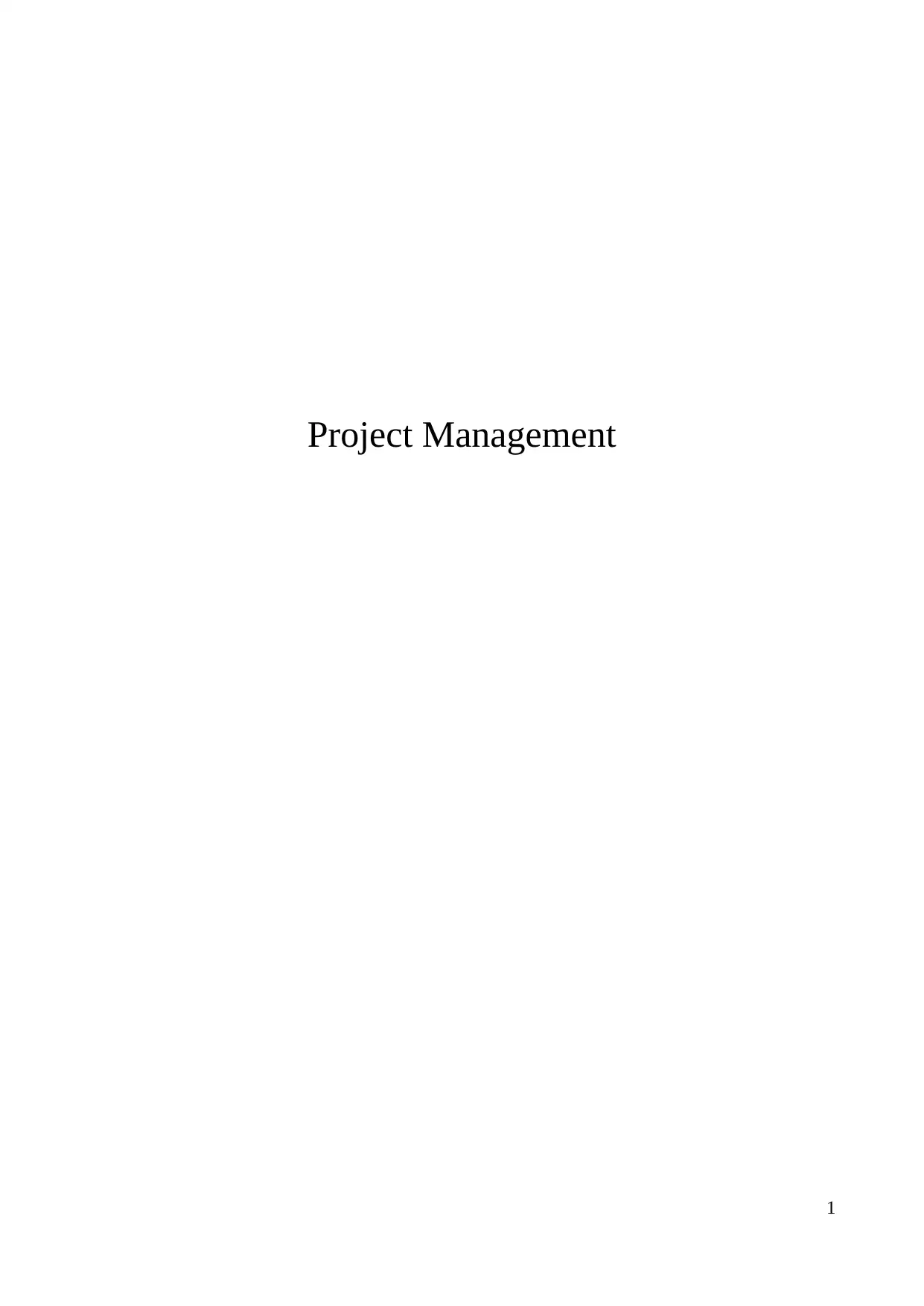
Project Management
1
1
Paraphrase This Document
Need a fresh take? Get an instant paraphrase of this document with our AI Paraphraser
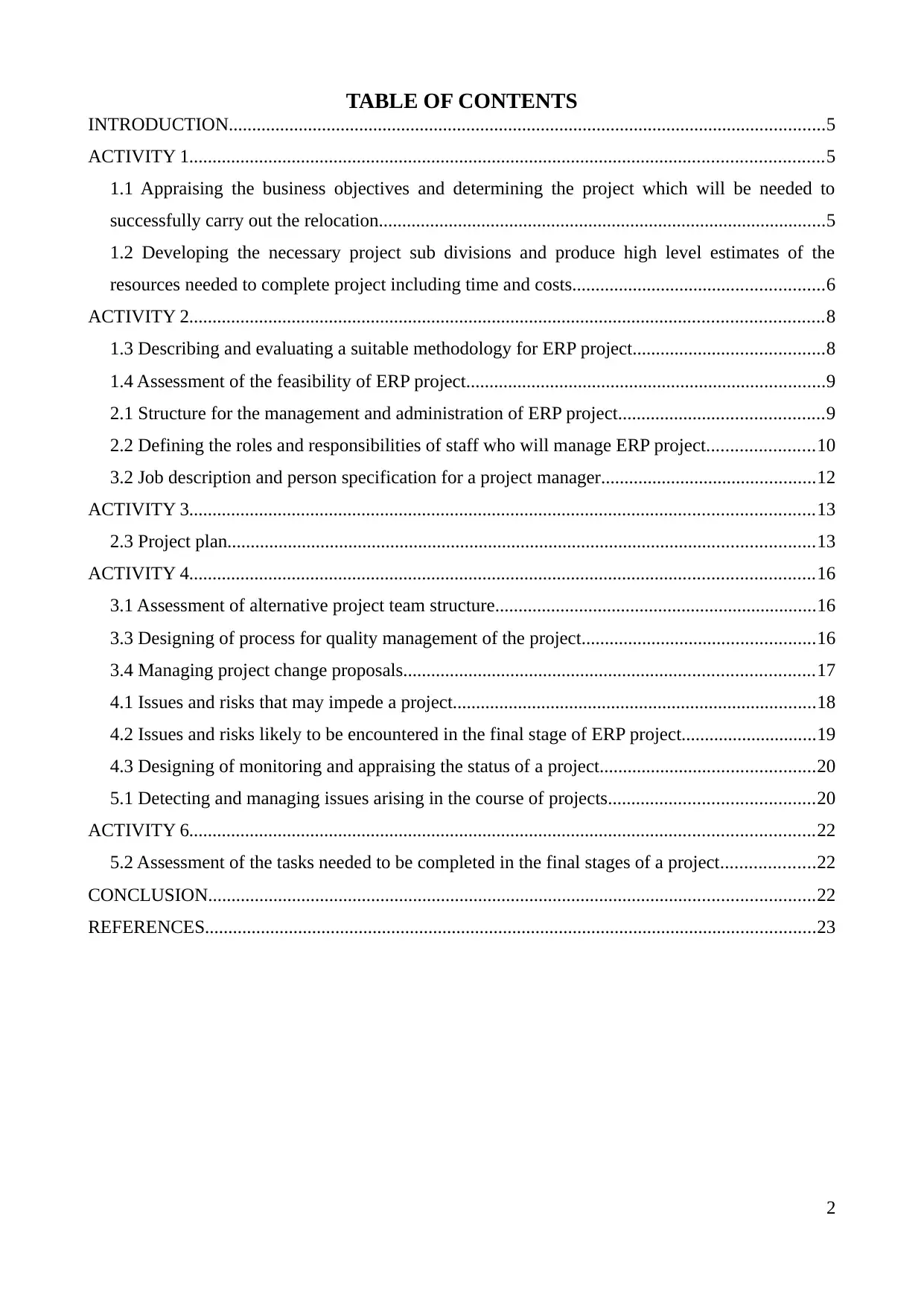
TABLE OF CONTENTS
INTRODUCTION................................................................................................................................5
ACTIVITY 1........................................................................................................................................5
1.1 Appraising the business objectives and determining the project which will be needed to
successfully carry out the relocation................................................................................................5
1.2 Developing the necessary project sub divisions and produce high level estimates of the
resources needed to complete project including time and costs......................................................6
ACTIVITY 2........................................................................................................................................8
1.3 Describing and evaluating a suitable methodology for ERP project.........................................8
1.4 Assessment of the feasibility of ERP project.............................................................................9
2.1 Structure for the management and administration of ERP project............................................9
2.2 Defining the roles and responsibilities of staff who will manage ERP project.......................10
3.2 Job description and person specification for a project manager..............................................12
ACTIVITY 3......................................................................................................................................13
2.3 Project plan..............................................................................................................................13
ACTIVITY 4......................................................................................................................................16
3.1 Assessment of alternative project team structure.....................................................................16
3.3 Designing of process for quality management of the project..................................................16
3.4 Managing project change proposals........................................................................................17
4.1 Issues and risks that may impede a project..............................................................................18
4.2 Issues and risks likely to be encountered in the final stage of ERP project.............................19
4.3 Designing of monitoring and appraising the status of a project..............................................20
5.1 Detecting and managing issues arising in the course of projects............................................20
ACTIVITY 6......................................................................................................................................22
5.2 Assessment of the tasks needed to be completed in the final stages of a project....................22
CONCLUSION..................................................................................................................................22
REFERENCES...................................................................................................................................23
2
INTRODUCTION................................................................................................................................5
ACTIVITY 1........................................................................................................................................5
1.1 Appraising the business objectives and determining the project which will be needed to
successfully carry out the relocation................................................................................................5
1.2 Developing the necessary project sub divisions and produce high level estimates of the
resources needed to complete project including time and costs......................................................6
ACTIVITY 2........................................................................................................................................8
1.3 Describing and evaluating a suitable methodology for ERP project.........................................8
1.4 Assessment of the feasibility of ERP project.............................................................................9
2.1 Structure for the management and administration of ERP project............................................9
2.2 Defining the roles and responsibilities of staff who will manage ERP project.......................10
3.2 Job description and person specification for a project manager..............................................12
ACTIVITY 3......................................................................................................................................13
2.3 Project plan..............................................................................................................................13
ACTIVITY 4......................................................................................................................................16
3.1 Assessment of alternative project team structure.....................................................................16
3.3 Designing of process for quality management of the project..................................................16
3.4 Managing project change proposals........................................................................................17
4.1 Issues and risks that may impede a project..............................................................................18
4.2 Issues and risks likely to be encountered in the final stage of ERP project.............................19
4.3 Designing of monitoring and appraising the status of a project..............................................20
5.1 Detecting and managing issues arising in the course of projects............................................20
ACTIVITY 6......................................................................................................................................22
5.2 Assessment of the tasks needed to be completed in the final stages of a project....................22
CONCLUSION..................................................................................................................................22
REFERENCES...................................................................................................................................23
2

LIST OF TABLE
Table 1 Time scale of ERP system project...........................................................................................8
Table 2 Project plan of ERP system...................................................................................................13
Table 1: Issues and risks that may impede a project..........................................................................18
3
Table 1 Time scale of ERP system project...........................................................................................8
Table 2 Project plan of ERP system...................................................................................................13
Table 1: Issues and risks that may impede a project..........................................................................18
3
⊘ This is a preview!⊘
Do you want full access?
Subscribe today to unlock all pages.

Trusted by 1+ million students worldwide

LIST OF FIGURES
4
4
Paraphrase This Document
Need a fresh take? Get an instant paraphrase of this document with our AI Paraphraser
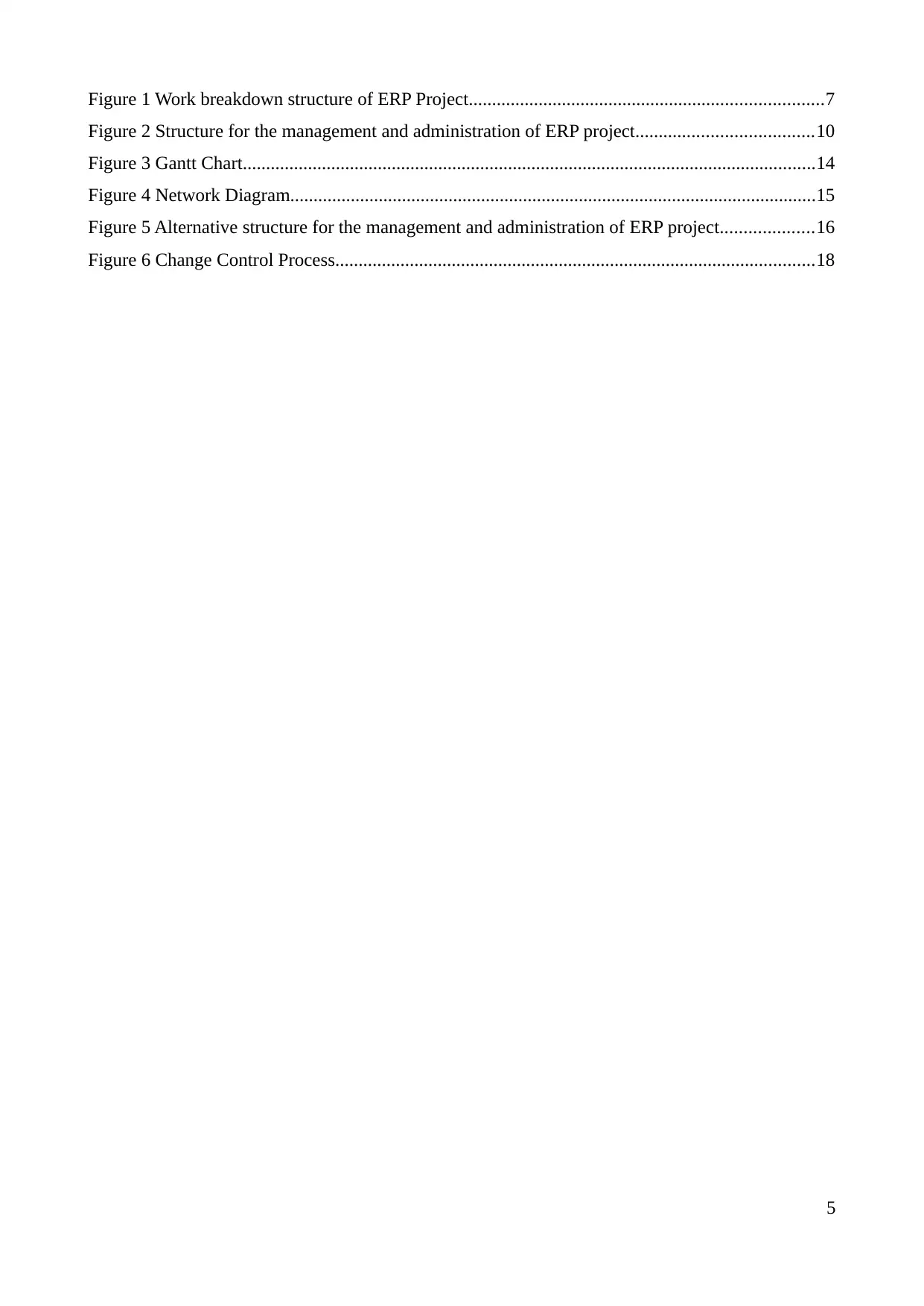
Figure 1 Work breakdown structure of ERP Project............................................................................7
Figure 2 Structure for the management and administration of ERP project......................................10
Figure 3 Gantt Chart...........................................................................................................................14
Figure 4 Network Diagram.................................................................................................................15
Figure 5 Alternative structure for the management and administration of ERP project....................16
Figure 6 Change Control Process.......................................................................................................18
5
Figure 2 Structure for the management and administration of ERP project......................................10
Figure 3 Gantt Chart...........................................................................................................................14
Figure 4 Network Diagram.................................................................................................................15
Figure 5 Alternative structure for the management and administration of ERP project....................16
Figure 6 Change Control Process.......................................................................................................18
5
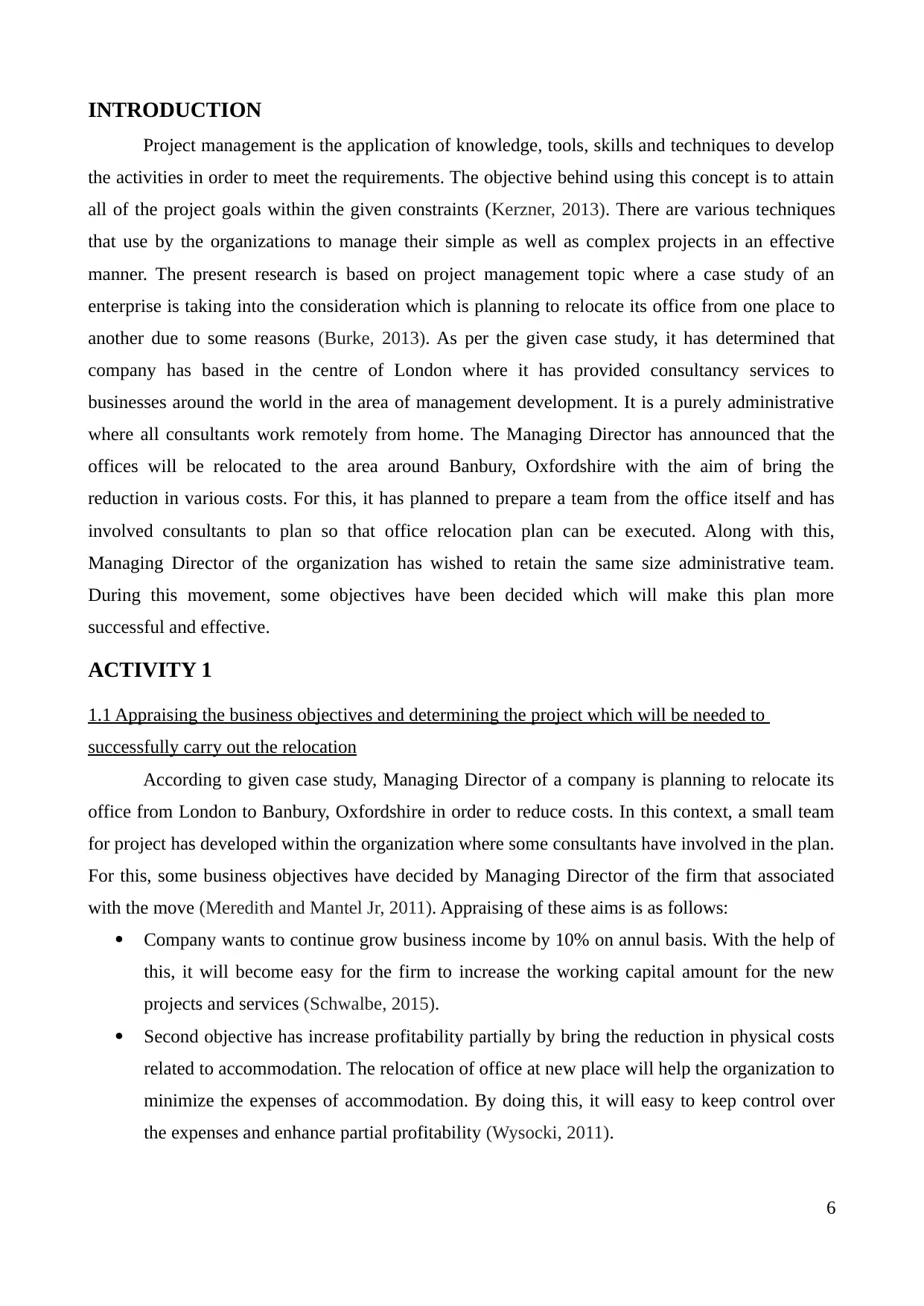
INTRODUCTION
Project management is the application of knowledge, tools, skills and techniques to develop
the activities in order to meet the requirements. The objective behind using this concept is to attain
all of the project goals within the given constraints (Kerzner, 2013). There are various techniques
that use by the organizations to manage their simple as well as complex projects in an effective
manner. The present research is based on project management topic where a case study of an
enterprise is taking into the consideration which is planning to relocate its office from one place to
another due to some reasons (Burke, 2013). As per the given case study, it has determined that
company has based in the centre of London where it has provided consultancy services to
businesses around the world in the area of management development. It is a purely administrative
where all consultants work remotely from home. The Managing Director has announced that the
offices will be relocated to the area around Banbury, Oxfordshire with the aim of bring the
reduction in various costs. For this, it has planned to prepare a team from the office itself and has
involved consultants to plan so that office relocation plan can be executed. Along with this,
Managing Director of the organization has wished to retain the same size administrative team.
During this movement, some objectives have been decided which will make this plan more
successful and effective.
ACTIVITY 1
1.1 Appraising the business objectives and determining the project which will be needed to
successfully carry out the relocation
According to given case study, Managing Director of a company is planning to relocate its
office from London to Banbury, Oxfordshire in order to reduce costs. In this context, a small team
for project has developed within the organization where some consultants have involved in the plan.
For this, some business objectives have decided by Managing Director of the firm that associated
with the move (Meredith and Mantel Jr, 2011). Appraising of these aims is as follows:
Company wants to continue grow business income by 10% on annul basis. With the help of
this, it will become easy for the firm to increase the working capital amount for the new
projects and services (Schwalbe, 2015).
Second objective has increase profitability partially by bring the reduction in physical costs
related to accommodation. The relocation of office at new place will help the organization to
minimize the expenses of accommodation. By doing this, it will easy to keep control over
the expenses and enhance partial profitability (Wysocki, 2011).
6
Project management is the application of knowledge, tools, skills and techniques to develop
the activities in order to meet the requirements. The objective behind using this concept is to attain
all of the project goals within the given constraints (Kerzner, 2013). There are various techniques
that use by the organizations to manage their simple as well as complex projects in an effective
manner. The present research is based on project management topic where a case study of an
enterprise is taking into the consideration which is planning to relocate its office from one place to
another due to some reasons (Burke, 2013). As per the given case study, it has determined that
company has based in the centre of London where it has provided consultancy services to
businesses around the world in the area of management development. It is a purely administrative
where all consultants work remotely from home. The Managing Director has announced that the
offices will be relocated to the area around Banbury, Oxfordshire with the aim of bring the
reduction in various costs. For this, it has planned to prepare a team from the office itself and has
involved consultants to plan so that office relocation plan can be executed. Along with this,
Managing Director of the organization has wished to retain the same size administrative team.
During this movement, some objectives have been decided which will make this plan more
successful and effective.
ACTIVITY 1
1.1 Appraising the business objectives and determining the project which will be needed to
successfully carry out the relocation
According to given case study, Managing Director of a company is planning to relocate its
office from London to Banbury, Oxfordshire in order to reduce costs. In this context, a small team
for project has developed within the organization where some consultants have involved in the plan.
For this, some business objectives have decided by Managing Director of the firm that associated
with the move (Meredith and Mantel Jr, 2011). Appraising of these aims is as follows:
Company wants to continue grow business income by 10% on annul basis. With the help of
this, it will become easy for the firm to increase the working capital amount for the new
projects and services (Schwalbe, 2015).
Second objective has increase profitability partially by bring the reduction in physical costs
related to accommodation. The relocation of office at new place will help the organization to
minimize the expenses of accommodation. By doing this, it will easy to keep control over
the expenses and enhance partial profitability (Wysocki, 2011).
6
⊘ This is a preview!⊘
Do you want full access?
Subscribe today to unlock all pages.

Trusted by 1+ million students worldwide
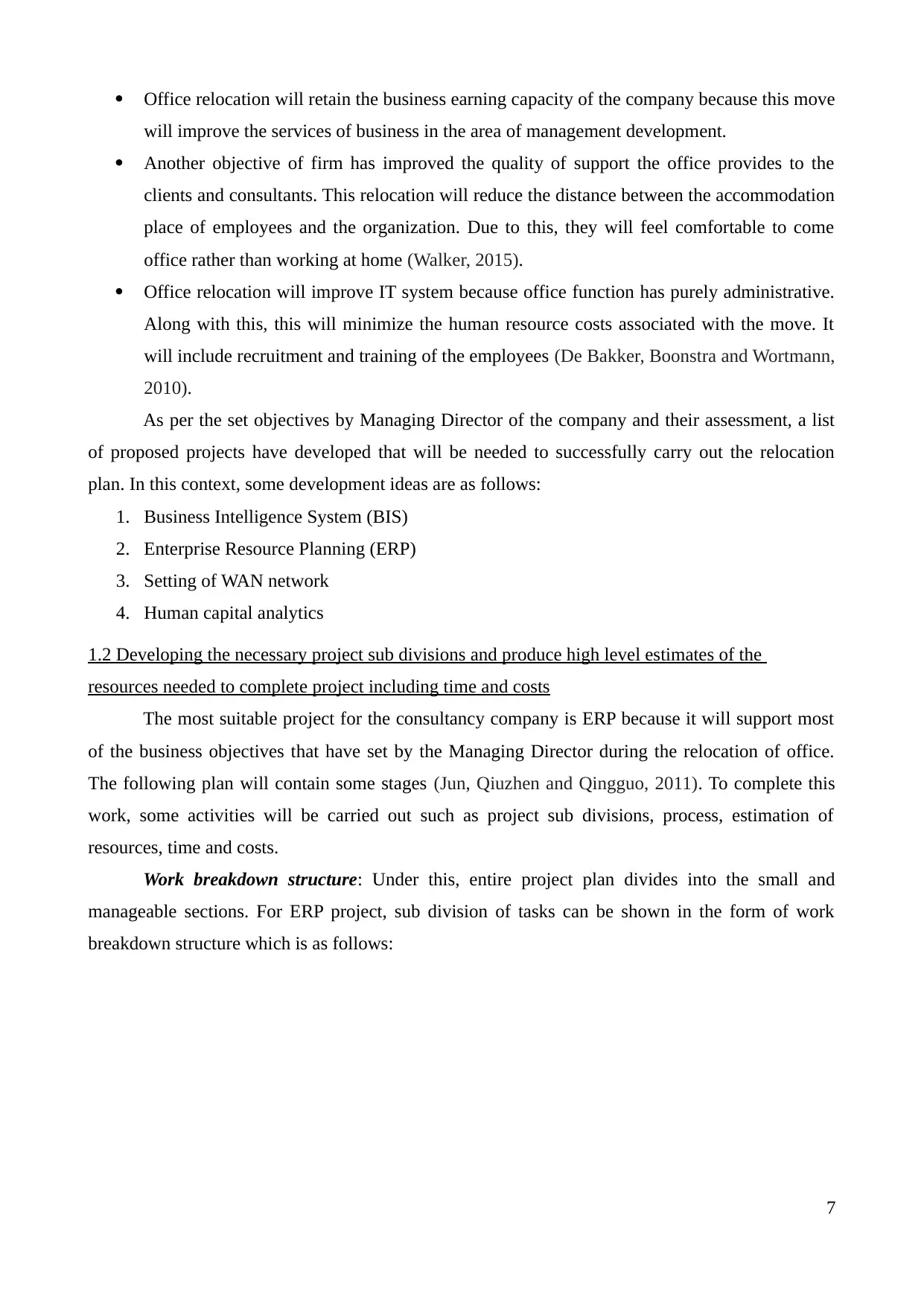
Office relocation will retain the business earning capacity of the company because this move
will improve the services of business in the area of management development.
Another objective of firm has improved the quality of support the office provides to the
clients and consultants. This relocation will reduce the distance between the accommodation
place of employees and the organization. Due to this, they will feel comfortable to come
office rather than working at home (Walker, 2015).
Office relocation will improve IT system because office function has purely administrative.
Along with this, this will minimize the human resource costs associated with the move. It
will include recruitment and training of the employees (De Bakker, Boonstra and Wortmann,
2010).
As per the set objectives by Managing Director of the company and their assessment, a list
of proposed projects have developed that will be needed to successfully carry out the relocation
plan. In this context, some development ideas are as follows:
1. Business Intelligence System (BIS)
2. Enterprise Resource Planning (ERP)
3. Setting of WAN network
4. Human capital analytics
1.2 Developing the necessary project sub divisions and produce high level estimates of the
resources needed to complete project including time and costs
The most suitable project for the consultancy company is ERP because it will support most
of the business objectives that have set by the Managing Director during the relocation of office.
The following plan will contain some stages (Jun, Qiuzhen and Qingguo, 2011). To complete this
work, some activities will be carried out such as project sub divisions, process, estimation of
resources, time and costs.
Work breakdown structure: Under this, entire project plan divides into the small and
manageable sections. For ERP project, sub division of tasks can be shown in the form of work
breakdown structure which is as follows:
7
will improve the services of business in the area of management development.
Another objective of firm has improved the quality of support the office provides to the
clients and consultants. This relocation will reduce the distance between the accommodation
place of employees and the organization. Due to this, they will feel comfortable to come
office rather than working at home (Walker, 2015).
Office relocation will improve IT system because office function has purely administrative.
Along with this, this will minimize the human resource costs associated with the move. It
will include recruitment and training of the employees (De Bakker, Boonstra and Wortmann,
2010).
As per the set objectives by Managing Director of the company and their assessment, a list
of proposed projects have developed that will be needed to successfully carry out the relocation
plan. In this context, some development ideas are as follows:
1. Business Intelligence System (BIS)
2. Enterprise Resource Planning (ERP)
3. Setting of WAN network
4. Human capital analytics
1.2 Developing the necessary project sub divisions and produce high level estimates of the
resources needed to complete project including time and costs
The most suitable project for the consultancy company is ERP because it will support most
of the business objectives that have set by the Managing Director during the relocation of office.
The following plan will contain some stages (Jun, Qiuzhen and Qingguo, 2011). To complete this
work, some activities will be carried out such as project sub divisions, process, estimation of
resources, time and costs.
Work breakdown structure: Under this, entire project plan divides into the small and
manageable sections. For ERP project, sub division of tasks can be shown in the form of work
breakdown structure which is as follows:
7
Paraphrase This Document
Need a fresh take? Get an instant paraphrase of this document with our AI Paraphraser
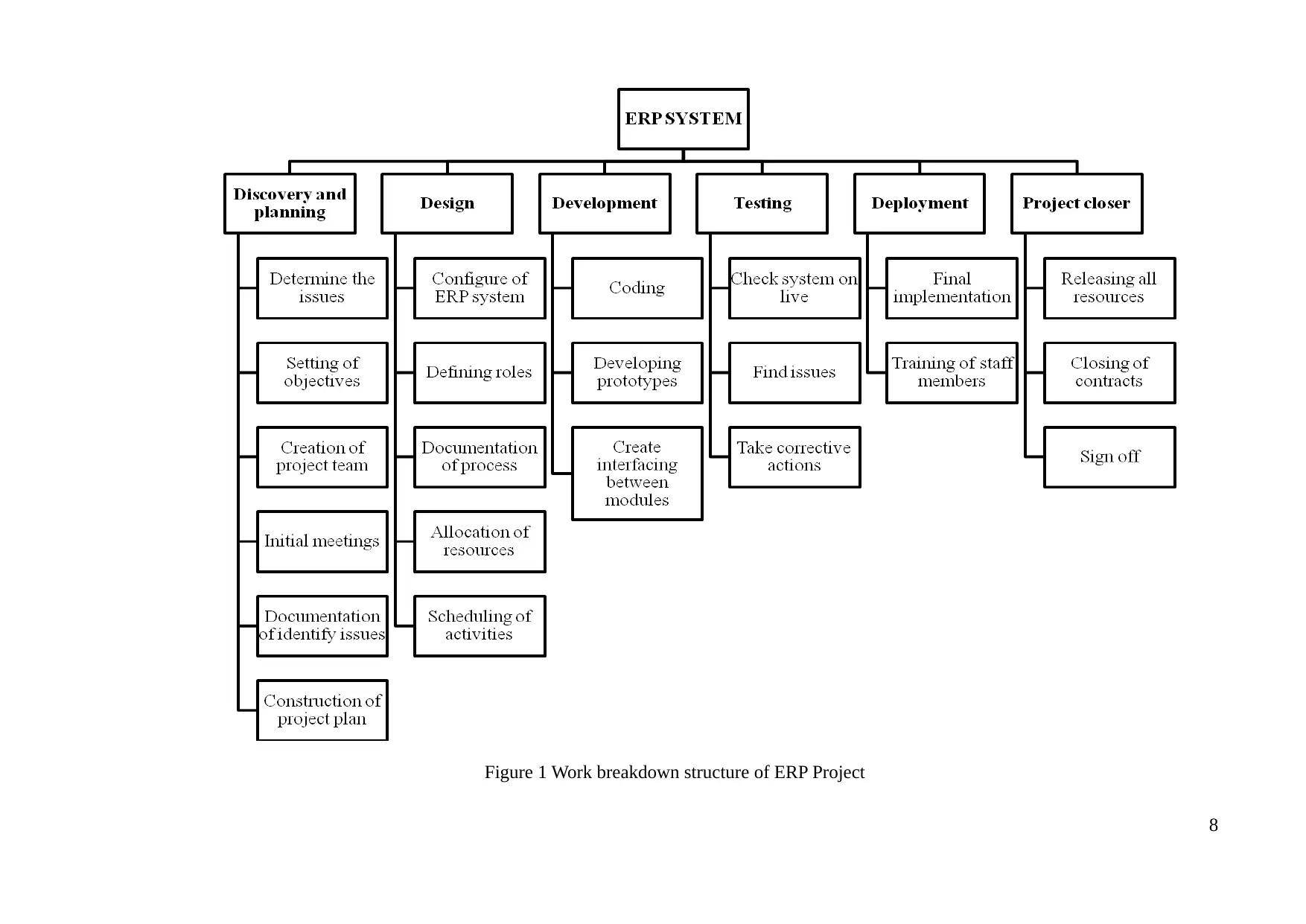
Figure 1 Work breakdown structure of ERP Project
8
8

Time scales: In order to complete whole ERP plan, timeframe will decided. The project will
finish within the 7 months. Along with this, for milestone activities, different time slots will allocate
in order to track the progress of the work. The time scale of project is giving in below table
Table 1 Time scale of ERP system project
Task Name Duration Start Finish
ERP SYSTEM 199 days Mon 2/6/17 Thu 11/9/17
Discovery and planning 29 days Mon 2/6/17 Thu 3/16/17
Design 25 days Fri 3/17/17 Thu 4/20/17
Development 115 days Fri 4/21/17 Thu 9/28/17
Testing 20 days Fri 9/29/17 Thu 10/26/17
Deployment 6 days Fri 10/27/17 Fri 11/3/17
Project closer 4 days Mon 11/6/17 Thu 11/9/17
Resources: In the terms of project management, some resources are required to carry out the
project tasks. Allocation of these have based on the priority of plan activities. For ERP project, the
major resources will people, equipments, technologies and space. In order to carry out various
phase of project plan, human resource will be needed who can develop and implement the scheme.
While, space will require where personnel can perform their assign works. Along with this,
equipments and technologies such as Project Management Software, Budgeting Tool, Performance
Management system etc will take into the consideration.
Project budget: The total budget to ERP project will be £52,000 where it will include
different aspects such as wages to project team members, buying new technologies, other additional
expenses etc.
Reporting and accountability: From the beginning to end of ERP project, all project team
members will report to project manager. The project manager will accountable to provide the
information about the project to Managing Director of consultancy company. Reporting structure
will be bottom to up.
ACTIVITY 2
1.3 Describing and evaluating a suitable methodology for ERP project
With the help of the PRINCE 2method, it becomes easy to assess ERP project. The several
stages of this technique will assist in analyse the plan at every phase. The expected outcomes of
each stage will compare the actual results to measure the performance. The seven principles, seven
themes and seven processes of PRINCE 2 will help each project member to understand own
responsibilities. It will assist in ensure the quality of project plan along with its timely delivery
9
finish within the 7 months. Along with this, for milestone activities, different time slots will allocate
in order to track the progress of the work. The time scale of project is giving in below table
Table 1 Time scale of ERP system project
Task Name Duration Start Finish
ERP SYSTEM 199 days Mon 2/6/17 Thu 11/9/17
Discovery and planning 29 days Mon 2/6/17 Thu 3/16/17
Design 25 days Fri 3/17/17 Thu 4/20/17
Development 115 days Fri 4/21/17 Thu 9/28/17
Testing 20 days Fri 9/29/17 Thu 10/26/17
Deployment 6 days Fri 10/27/17 Fri 11/3/17
Project closer 4 days Mon 11/6/17 Thu 11/9/17
Resources: In the terms of project management, some resources are required to carry out the
project tasks. Allocation of these have based on the priority of plan activities. For ERP project, the
major resources will people, equipments, technologies and space. In order to carry out various
phase of project plan, human resource will be needed who can develop and implement the scheme.
While, space will require where personnel can perform their assign works. Along with this,
equipments and technologies such as Project Management Software, Budgeting Tool, Performance
Management system etc will take into the consideration.
Project budget: The total budget to ERP project will be £52,000 where it will include
different aspects such as wages to project team members, buying new technologies, other additional
expenses etc.
Reporting and accountability: From the beginning to end of ERP project, all project team
members will report to project manager. The project manager will accountable to provide the
information about the project to Managing Director of consultancy company. Reporting structure
will be bottom to up.
ACTIVITY 2
1.3 Describing and evaluating a suitable methodology for ERP project
With the help of the PRINCE 2method, it becomes easy to assess ERP project. The several
stages of this technique will assist in analyse the plan at every phase. The expected outcomes of
each stage will compare the actual results to measure the performance. The seven principles, seven
themes and seven processes of PRINCE 2 will help each project member to understand own
responsibilities. It will assist in ensure the quality of project plan along with its timely delivery
9
⊘ This is a preview!⊘
Do you want full access?
Subscribe today to unlock all pages.

Trusted by 1+ million students worldwide
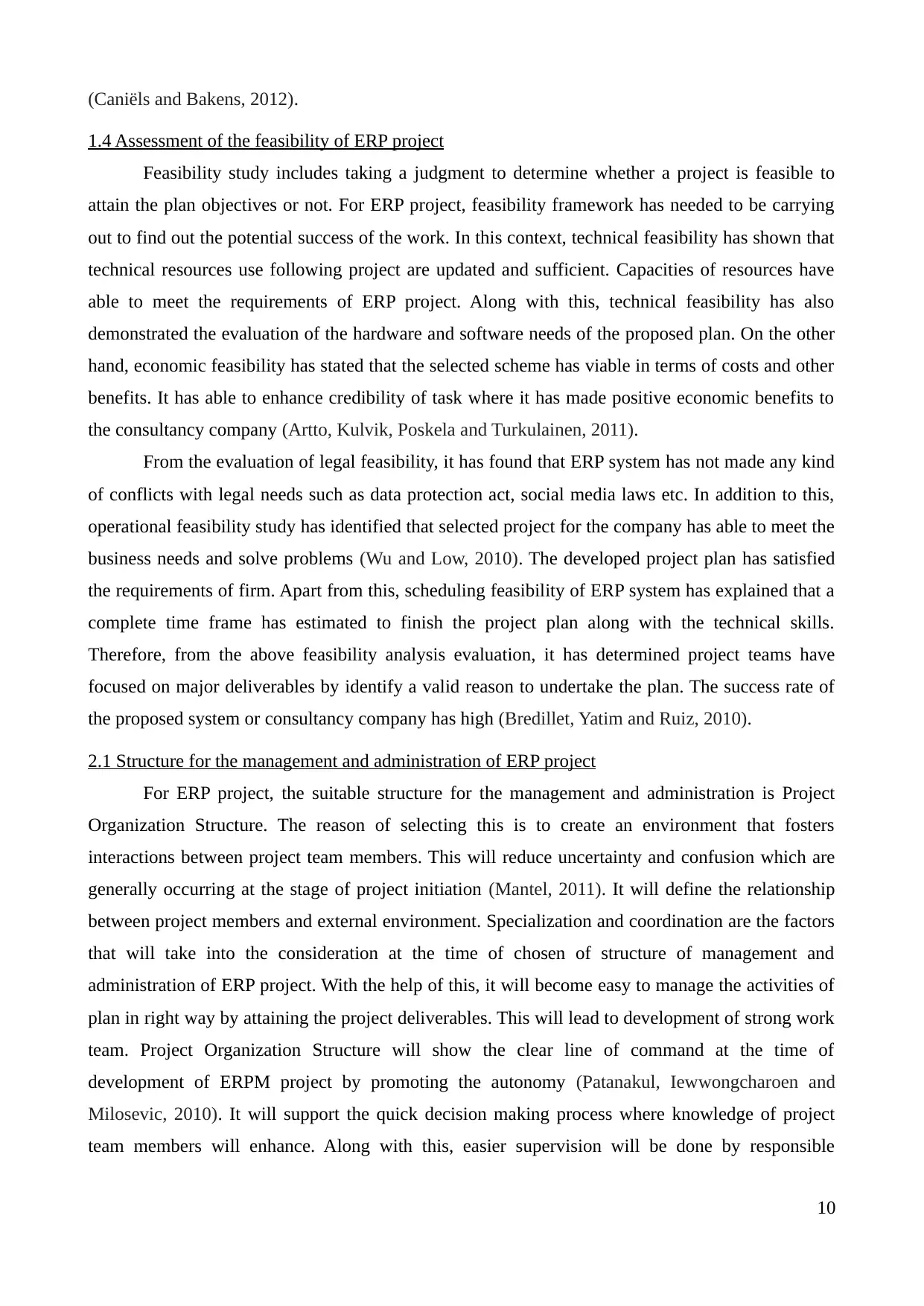
(Caniëls and Bakens, 2012).
1.4 Assessment of the feasibility of ERP project
Feasibility study includes taking a judgment to determine whether a project is feasible to
attain the plan objectives or not. For ERP project, feasibility framework has needed to be carrying
out to find out the potential success of the work. In this context, technical feasibility has shown that
technical resources use following project are updated and sufficient. Capacities of resources have
able to meet the requirements of ERP project. Along with this, technical feasibility has also
demonstrated the evaluation of the hardware and software needs of the proposed plan. On the other
hand, economic feasibility has stated that the selected scheme has viable in terms of costs and other
benefits. It has able to enhance credibility of task where it has made positive economic benefits to
the consultancy company (Artto, Kulvik, Poskela and Turkulainen, 2011).
From the evaluation of legal feasibility, it has found that ERP system has not made any kind
of conflicts with legal needs such as data protection act, social media laws etc. In addition to this,
operational feasibility study has identified that selected project for the company has able to meet the
business needs and solve problems (Wu and Low, 2010). The developed project plan has satisfied
the requirements of firm. Apart from this, scheduling feasibility of ERP system has explained that a
complete time frame has estimated to finish the project plan along with the technical skills.
Therefore, from the above feasibility analysis evaluation, it has determined project teams have
focused on major deliverables by identify a valid reason to undertake the plan. The success rate of
the proposed system or consultancy company has high (Bredillet, Yatim and Ruiz, 2010).
2.1 Structure for the management and administration of ERP project
For ERP project, the suitable structure for the management and administration is Project
Organization Structure. The reason of selecting this is to create an environment that fosters
interactions between project team members. This will reduce uncertainty and confusion which are
generally occurring at the stage of project initiation (Mantel, 2011). It will define the relationship
between project members and external environment. Specialization and coordination are the factors
that will take into the consideration at the time of chosen of structure of management and
administration of ERP project. With the help of this, it will become easy to manage the activities of
plan in right way by attaining the project deliverables. This will lead to development of strong work
team. Project Organization Structure will show the clear line of command at the time of
development of ERPM project by promoting the autonomy (Patanakul, Iewwongcharoen and
Milosevic, 2010). It will support the quick decision making process where knowledge of project
team members will enhance. Along with this, easier supervision will be done by responsible
10
1.4 Assessment of the feasibility of ERP project
Feasibility study includes taking a judgment to determine whether a project is feasible to
attain the plan objectives or not. For ERP project, feasibility framework has needed to be carrying
out to find out the potential success of the work. In this context, technical feasibility has shown that
technical resources use following project are updated and sufficient. Capacities of resources have
able to meet the requirements of ERP project. Along with this, technical feasibility has also
demonstrated the evaluation of the hardware and software needs of the proposed plan. On the other
hand, economic feasibility has stated that the selected scheme has viable in terms of costs and other
benefits. It has able to enhance credibility of task where it has made positive economic benefits to
the consultancy company (Artto, Kulvik, Poskela and Turkulainen, 2011).
From the evaluation of legal feasibility, it has found that ERP system has not made any kind
of conflicts with legal needs such as data protection act, social media laws etc. In addition to this,
operational feasibility study has identified that selected project for the company has able to meet the
business needs and solve problems (Wu and Low, 2010). The developed project plan has satisfied
the requirements of firm. Apart from this, scheduling feasibility of ERP system has explained that a
complete time frame has estimated to finish the project plan along with the technical skills.
Therefore, from the above feasibility analysis evaluation, it has determined project teams have
focused on major deliverables by identify a valid reason to undertake the plan. The success rate of
the proposed system or consultancy company has high (Bredillet, Yatim and Ruiz, 2010).
2.1 Structure for the management and administration of ERP project
For ERP project, the suitable structure for the management and administration is Project
Organization Structure. The reason of selecting this is to create an environment that fosters
interactions between project team members. This will reduce uncertainty and confusion which are
generally occurring at the stage of project initiation (Mantel, 2011). It will define the relationship
between project members and external environment. Specialization and coordination are the factors
that will take into the consideration at the time of chosen of structure of management and
administration of ERP project. With the help of this, it will become easy to manage the activities of
plan in right way by attaining the project deliverables. This will lead to development of strong work
team. Project Organization Structure will show the clear line of command at the time of
development of ERPM project by promoting the autonomy (Patanakul, Iewwongcharoen and
Milosevic, 2010). It will support the quick decision making process where knowledge of project
team members will enhance. Along with this, easier supervision will be done by responsible
10
Paraphrase This Document
Need a fresh take? Get an instant paraphrase of this document with our AI Paraphraser

personnel at every stage of plan. In this context, structure of the management and administration of
ERP project is as follows:
Figure 2 Structure for the management and administration of ERP project
2.2 Defining the roles and responsibilities of staff who will manage ERP project
In ERP project, project team will play some important roles and responsibilities which are as
follows:
Project manager:
Managing and leading the project team
Selection of project staffs and consultants (Bredillet, 2010)
Accountable for detailed project planning and controlling
Developing and implementing a systematic and detailed project plan
Resolving cross functional issues at different phases of project plan
Working closely with the company to make sure the proposed project meet the requirements
of the business (Lee and Yu, 2012)
Determining user training needs and organize training events for them
Managing scope of the project and change control process
Project sponsor:
Accountable for the delivery of planned benefits related to ERP project
11
ERP project is as follows:
Figure 2 Structure for the management and administration of ERP project
2.2 Defining the roles and responsibilities of staff who will manage ERP project
In ERP project, project team will play some important roles and responsibilities which are as
follows:
Project manager:
Managing and leading the project team
Selection of project staffs and consultants (Bredillet, 2010)
Accountable for detailed project planning and controlling
Developing and implementing a systematic and detailed project plan
Resolving cross functional issues at different phases of project plan
Working closely with the company to make sure the proposed project meet the requirements
of the business (Lee and Yu, 2012)
Determining user training needs and organize training events for them
Managing scope of the project and change control process
Project sponsor:
Accountable for the delivery of planned benefits related to ERP project
11

Ensuring resolution of issues developed between the project board and project manager
Taking major decisions within the context of project plan (Hwang and Tan, 2012)
Make sure about the availability of important resources.
Approving budget and scheduling of the project plan
Project board:
Approving strategies, execution of plan, project scope and setting of milestones
Driving and managing alterations within the plan (Portny, 2010)
Prioritising goals of ERP project and developing of plan deliverables.
Establishing communication with project manager and other team members
Consultants:
Ensuring that project requirements are meet by ERP project
Managing the budget for entire plan (Heising, 2012)
Make sure about the effective use of the resources during the project plan
Act as mediator between the project board and project manager
Project team members:
Providing functional expertise in an administrative process (Patanakul and Shenhar, 2012)
Analyzing and documentation of whole project plan and its processes
Work with consultancy company to make certain that project meets business requirements
Determining the needs of consultancy organization related to office relocation (Morris,
2010)
System developer
Migration of data
Create interface of ERP system with other systems (Killen and Hunt, 2010)
Setting of security rights and access permissions
Contribute in developing technical requirements and related policies
Development of technical testing programs (Morris and Pinto, 2010)
System administrator
Support and management of network operating systems
Measures disaster and back-up recovery measures
Managing data base
Contribute in development of technical strategies and related processes (Kerzner, 2013)
3.2 Job description and person specification for a project manager
Job description
12
Taking major decisions within the context of project plan (Hwang and Tan, 2012)
Make sure about the availability of important resources.
Approving budget and scheduling of the project plan
Project board:
Approving strategies, execution of plan, project scope and setting of milestones
Driving and managing alterations within the plan (Portny, 2010)
Prioritising goals of ERP project and developing of plan deliverables.
Establishing communication with project manager and other team members
Consultants:
Ensuring that project requirements are meet by ERP project
Managing the budget for entire plan (Heising, 2012)
Make sure about the effective use of the resources during the project plan
Act as mediator between the project board and project manager
Project team members:
Providing functional expertise in an administrative process (Patanakul and Shenhar, 2012)
Analyzing and documentation of whole project plan and its processes
Work with consultancy company to make certain that project meets business requirements
Determining the needs of consultancy organization related to office relocation (Morris,
2010)
System developer
Migration of data
Create interface of ERP system with other systems (Killen and Hunt, 2010)
Setting of security rights and access permissions
Contribute in developing technical requirements and related policies
Development of technical testing programs (Morris and Pinto, 2010)
System administrator
Support and management of network operating systems
Measures disaster and back-up recovery measures
Managing data base
Contribute in development of technical strategies and related processes (Kerzner, 2013)
3.2 Job description and person specification for a project manager
Job description
12
⊘ This is a preview!⊘
Do you want full access?
Subscribe today to unlock all pages.

Trusted by 1+ million students worldwide
1 out of 26
Related Documents
Your All-in-One AI-Powered Toolkit for Academic Success.
+13062052269
info@desklib.com
Available 24*7 on WhatsApp / Email
![[object Object]](/_next/static/media/star-bottom.7253800d.svg)
Unlock your academic potential
Copyright © 2020–2025 A2Z Services. All Rights Reserved. Developed and managed by ZUCOL.





